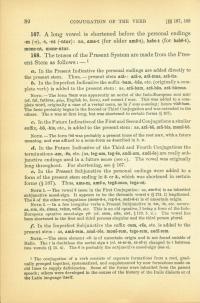168. The tenses of the Present System are made from the Present Stem as follows.1
a. In the Present Indicative the personal endings are added directly to the Present stem.
present stem arā-:
arā-s
arā-mus
arā-tis
b. In the Imperfect Indicative the suffix -bam, -bās, etc. (originally a complete verb) is added to the Present stem.
arā-bam
arā-bās
arā-bāmus2
c. In the Future Indicative of the 1st and 2nd Conjugations a similar suffix, -bō, -bis, etc., is added to the Present stem.
arā-bō, arā-bis
monē-bō3
d. In the Future Indicative of the 3rd and 4th Conjugations the terminations -am, -ēs, etc., are really Subjunctive endings used in a future sense (see e). The vowel was originally long throughout. For shortening, see § 167.
teg-am, teg-ēs
audi-am, audi-ēs
e. In the Present Subjunctive the personal endings were added to a form of the present stem ending in -ē- or -ā-, which was shortened in certain forms (§ 167).
ame-m, amē-s
tegā-mus, tega-nt
Note 1— The vowel ē (seen in the 1st Conjugation am-ë-s, etc.) is an inherited subjunctive mood sign. It appears to be the thematic vowel e (§ 174.1) lengthened. The ā of the other conjugations (mone-ā-s, reg-ā-s, audi-ā-s) is of uncertain origin.
Note 2— In a few irregular verbs a Present Subjunctive in -im, -īs, etc. occurs.
sim, sīs, sīmus,
velim, velīs, etc.
This is an old optative, ī being a form of the Indo-European optative mood sign yē- (cf. siem, siēs, siet, § 170.b, Note). The vowel has been shortened in the first and third persons singular and the third person plural.
f. In the Imperfect Subjunctive the suffix -rem, -rēs, etc. is added to the Present stem.
amā-rem, amā-rēs
monē-rem
tege-rem
audī-rem4
Footnotes
2. The form †bam was apparently an Aorist of the Indo-European root BHU (cf. fuī, futūrus, φύω, English be, been) and meant I was. This was added to a complete word, originally a case of a verbal noun, as in I was a-seeing; hence vidē-bam. The form probably began in the 2nd or 3rd Conjugation and was extended to the others. The a was at first long, but was shortened in certain forms (§ 167).
3. The form †bō was probably a present tense of the root BHU, with a future meaning, and was affixed to a noun-form as described in footnote 2.
4. The stem element -rē - is of uncertain origin and is not found outside of Italic. The r is doubtless the Aorist sign s (cf. es-se-m, es-sē-s) changed to r between two vowels (§ 15.4). The ē is probably the subjunctive mood-sign (see e., above).

